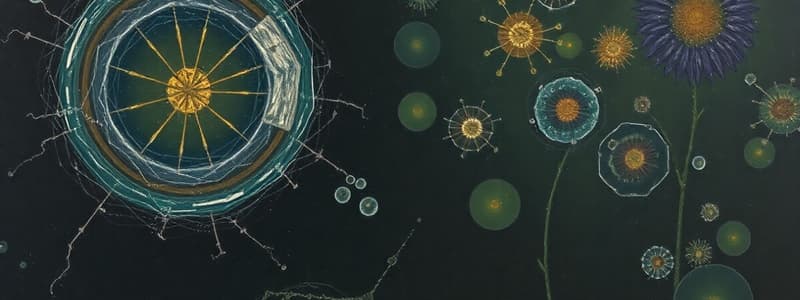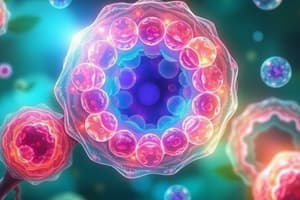Podcast
Questions and Answers
What is the primary function of mitochondria in a cell?
What is the primary function of mitochondria in a cell?
- Protein synthesis
- Storing genetic material
- Photosynthesis
- Generating ATP through cellular respiration (correct)
Which structure is unique to plant cells and provides additional support?
Which structure is unique to plant cells and provides additional support?
- Chloroplast
- Cell wall (correct)
- Cell membrane
- Lysosome
What statement best describes the function of ribosomes in a cell?
What statement best describes the function of ribosomes in a cell?
- Synthesize proteins using mRNA instructions (correct)
- Store water and maintain turgor pressure
- Control cell activities and store DNA
- Modify and package proteins for secretion
What is the main effect of osmosis on plant cells?
What is the main effect of osmosis on plant cells?
Which organelle is responsible for modifying and sorting proteins before secretion?
Which organelle is responsible for modifying and sorting proteins before secretion?
What do lysosomes primarily do within a cell?
What do lysosomes primarily do within a cell?
How does the rough endoplasmic reticulum differ from the smooth endoplasmic reticulum?
How does the rough endoplasmic reticulum differ from the smooth endoplasmic reticulum?
Which of the following correctly describes cell theory?
Which of the following correctly describes cell theory?
What is the primary purpose of cellular respiration?
What is the primary purpose of cellular respiration?
Which of the following correctly describes diffusion?
Which of the following correctly describes diffusion?
During which phase of the cell cycle is DNA replicated?
During which phase of the cell cycle is DNA replicated?
What is the total magnification if the eyepiece is set at 10x and the objective lens is set at 100x?
What is the total magnification if the eyepiece is set at 10x and the objective lens is set at 100x?
What crucial role does DNA play in cells?
What crucial role does DNA play in cells?
Which stage of mitosis involves chromosomes aligning at the cell's equator?
Which stage of mitosis involves chromosomes aligning at the cell's equator?
What occurs during cytokinesis in animal cells?
What occurs during cytokinesis in animal cells?
What key function do checkpoints serve in the cell cycle?
What key function do checkpoints serve in the cell cycle?
Which of the following statements about plant and animal cell mitosis is correct?
Which of the following statements about plant and animal cell mitosis is correct?
What can result from errors in the cell cycle?
What can result from errors in the cell cycle?
Flashcards
What is a cell?
What is a cell?
The basic unit of life; the smallest structure that can carry out all the functions necessary for life, such as metabolism and reproduction.
What is cell theory?
What is cell theory?
The theory that states that all living organisms are composed of cells, are the basic unit of life, and arise from pre-existing cells.
What is an organelle?
What is an organelle?
A membrane-bound structure found within a cell that performs a specific function.
What is the nucleus?
What is the nucleus?
Signup and view all the flashcards
What is the mitochondria?
What is the mitochondria?
Signup and view all the flashcards
What is osmosis?
What is osmosis?
Signup and view all the flashcards
What is diffusion?
What is diffusion?
Signup and view all the flashcards
What is the cell wall?
What is the cell wall?
Signup and view all the flashcards
Diffusion
Diffusion
Signup and view all the flashcards
Cellular Respiration
Cellular Respiration
Signup and view all the flashcards
Mitochondria
Mitochondria
Signup and view all the flashcards
ATP (Adenosine Triphosphate)
ATP (Adenosine Triphosphate)
Signup and view all the flashcards
Total Magnification
Total Magnification
Signup and view all the flashcards
Mitosis
Mitosis
Signup and view all the flashcards
Interphase
Interphase
Signup and view all the flashcards
Cytokinesis
Cytokinesis
Signup and view all the flashcards
Cell Cycle Checkpoints
Cell Cycle Checkpoints
Signup and view all the flashcards
Cancer
Cancer
Signup and view all the flashcards
Study Notes
Cell Theory
- All living organisms are composed of cells.
- Cells are the fundamental units of life from single-celled to multi-celled.
- Cells perform all life processes (metabolism, reproduction).
- All new cells emerge from pre-existing cells.
Animal and Plant Cells
Animal Cells
- Typically round or irregular shapes.
- Nucleus: Contains DNA, controls cell activity.
- Mitochondria: Site of cellular respiration (energy production).
- Ribosomes: Synthesize proteins.
- Endoplasmic Reticulum (ER): Rough (protein) and smooth (lipid) synthesis, transport.
- Golgi Apparatus: Modifies, sorts, and packages proteins.
- Lysosomes: Contain enzymes to break down waste.
- Cytoplasm: Jelly-like substance where reactions occur.
Plant Cells
- Typically rectangular or box-like shapes.
- Cell Wall: Provides structural support and protection (cellulose).
- Chloroplasts: Site of photosynthesis.
- Vacuole: Large central vacuole for water storage and turgor pressure.
- Plasmodesmata: Channels connecting plant cells.
Organelle Functions
- Nucleus: Stores genetic material, directs cell activities.
- Mitochondria: Create ATP (energy) via cellular respiration.
- Ribosomes: Synthesize proteins.
- Endoplasmic Reticulum (ER): Rough ER makes proteins, smooth ER makes lipids and detoxifies.
- Golgi Apparatus: Modifies, packages, and transports proteins.
- Lysosomes: Digest cellular waste and foreign material.
- Vacuoles: Store nutrients, waste, and maintain pressure in plant cells.
- Cell Membrane: Regulates materials entering and leaving the cell.
Osmosis and Diffusion
- Osmosis: Water movement across a membrane from low to high solute concentration. (e.g., water entering plant cells).
- Diffusion: Movement of molecules from high to low concentration (e.g., oxygen into blood cells).
Energy Generation in Cells
- Location: Mitochondria.
- Reaction: Cellular respiration converts glucose and oxygen into carbon dioxide, water, and ATP (energy).
- Equation: C₆H₁₂O₆ + O₂ → CO₂ + H₂O + ATP
Microscope Calculations
- Total Magnification: Eyepiece magnification x objective lens magnification (e.g., 10x eyepiece x 40x objective = 400x).
- Field of View: Field of view at lower magnification x magnification at higher magnification / magnification at lower magnification
- Cell Size: Field of view / Number of cells across the field.
Importance of DNA
- DNA carries genetic instructions for development, growth, function, and reproduction.
- Accurate DNA is crucial for proper cellular function.
- Mutations in DNA can cause diseases (e.g., cancer).
Cell Division and Mitosis
- Reasons for division: Growth, repair, and asexual reproduction.
- Interphase: Cell grows & DNA replicates (G1, S, G2 phases).
- Mitosis Stages: Prophase, Metaphase, Anaphase, Telophase.
- Prophase: Chromosomes condense, nuclear envelope breaks down.
- Metaphase: Chromosomes align at the center.
- Anaphase: Sister chromatids separate.
- Telophase: Nuclear envelope reforms.
- Cytokinesis: Cytoplasm divides, producing two daughter cells.
- Plant vs. Animal Mitosis: Plant cells form a cell plate during cytokinesis; animal cells form a cleavage furrow.
The Cell Cycle
- Cycle Steps: Interphase, Mitosis, Cytokinesis.
- Checkpoints: Control points in the cell cycle that ensure accuracy (G1, G2, M checkpoints).
- Problems from Disturbances: Uncontrolled cell division (cancer), genetic disorders.
Studying That Suits You
Use AI to generate personalized quizzes and flashcards to suit your learning preferences.




